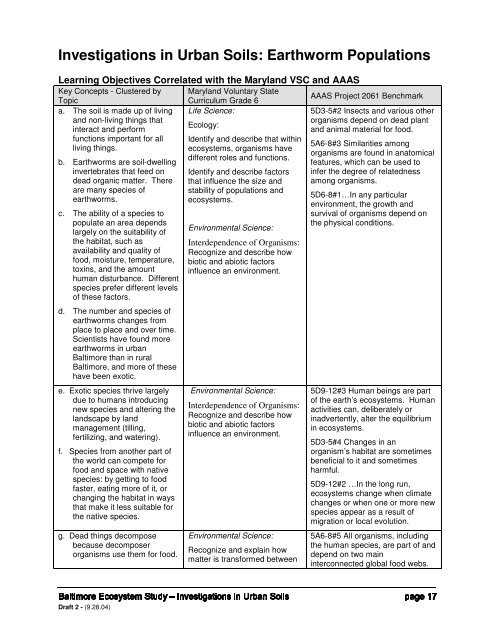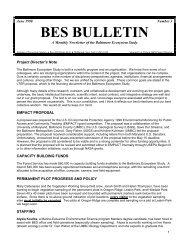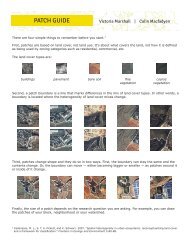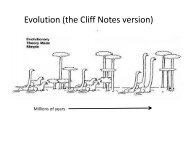Investigations in Urban Soils - Baltimore Ecosystem Study
Investigations in Urban Soils - Baltimore Ecosystem Study
Investigations in Urban Soils - Baltimore Ecosystem Study
You also want an ePaper? Increase the reach of your titles
YUMPU automatically turns print PDFs into web optimized ePapers that Google loves.
<strong>Investigations</strong> <strong>in</strong> <strong>Urban</strong> <strong>Soils</strong>: Earthworm Populations<br />
Learn<strong>in</strong>g Objectives Correlated with the Maryland VSC and AAAS<br />
Key Concepts - Clustered by<br />
Topic<br />
a. The soil is made up of liv<strong>in</strong>g<br />
and non-liv<strong>in</strong>g th<strong>in</strong>gs that<br />
<strong>in</strong>teract and perform<br />
functions important for all<br />
liv<strong>in</strong>g th<strong>in</strong>gs.<br />
b. Earthworms are soil-dwell<strong>in</strong>g<br />
<strong>in</strong>vertebrates that feed on<br />
dead organic matter. There<br />
are many species of<br />
earthworms.<br />
c. The ability of a species to<br />
populate an area depends<br />
largely on the suitability of<br />
the habitat, such as<br />
availability and quality of<br />
food, moisture, temperature,<br />
tox<strong>in</strong>s, and the amount<br />
human disturbance. Different<br />
species prefer different levels<br />
of these factors.<br />
d. The number and species of<br />
earthworms changes from<br />
place to place and over time.<br />
Scientists have found more<br />
earthworms <strong>in</strong> urban<br />
<strong>Baltimore</strong> than <strong>in</strong> rural<br />
<strong>Baltimore</strong>, and more of these<br />
have been exotic.<br />
e. Exotic species thrive largely<br />
due to humans <strong>in</strong>troduc<strong>in</strong>g<br />
new species and alter<strong>in</strong>g the<br />
landscape by land<br />
management (till<strong>in</strong>g,<br />
fertiliz<strong>in</strong>g, and water<strong>in</strong>g).<br />
f. Species from another part of<br />
the world can compete for<br />
food and space with native<br />
species: by gett<strong>in</strong>g to food<br />
faster, eat<strong>in</strong>g more of it, or<br />
chang<strong>in</strong>g the habitat <strong>in</strong> ways<br />
that make it less suitable for<br />
the native species.<br />
g. Dead th<strong>in</strong>gs decompose<br />
because decomposer<br />
organisms use them for food.<br />
Maryland Voluntary State<br />
Curriculum Grade 6<br />
Life Science:<br />
Ecology:<br />
Identify and describe that with<strong>in</strong><br />
ecosystems, organisms have<br />
different roles and functions.<br />
Identify and describe factors<br />
that <strong>in</strong>fluence the size and<br />
stability of populations and<br />
ecosystems.<br />
Environmental Science:<br />
Interdependence of Organisms:<br />
Recognize and describe how<br />
biotic and abiotic factors<br />
<strong>in</strong>fluence an environment.<br />
Environmental Science:<br />
Interdependence of Organisms:<br />
Recognize and describe how<br />
biotic and abiotic factors<br />
<strong>in</strong>fluence an environment.<br />
Environmental Science:<br />
Recognize and expla<strong>in</strong> how<br />
matter is transformed between<br />
AAAS Project 2061 Benchmark<br />
5D3-5#2 Insects and various other<br />
organisms depend on dead plant<br />
and animal material for food.<br />
5A6-8#3 Similarities among<br />
organisms are found <strong>in</strong> anatomical<br />
features, which can be used to<br />
<strong>in</strong>fer the degree of relatedness<br />
among organisms.<br />
5D6-8#1…In any particular<br />
environment, the growth and<br />
survival of organisms depend on<br />
the physical conditions.<br />
5D9-12#3 Human be<strong>in</strong>gs are part<br />
of the earth’s ecosystems. Human<br />
activities can, deliberately or<br />
<strong>in</strong>advertently, alter the equilibrium<br />
<strong>in</strong> ecosystems.<br />
5D3-5#4 Changes <strong>in</strong> an<br />
organism’s habitat are sometimes<br />
beneficial to it and sometimes<br />
harmful.<br />
5D9-12#2 …In the long run,<br />
ecosystems change when climate<br />
changes or when one or more new<br />
species appear as a result of<br />
migration or local evolution.<br />
5A6-8#5 All organisms, <strong>in</strong>clud<strong>in</strong>g<br />
the human species, are part of and<br />
depend on two ma<strong>in</strong><br />
<strong>in</strong>terconnected global food webs.<br />
Draft 2 - (9.28.04)<br />
<strong>Baltimore</strong> <strong>Ecosystem</strong> <strong>Study</strong> – <strong>Investigations</strong> <strong>in</strong> <strong>Urban</strong> <strong>Soils</strong><br />
page 17






